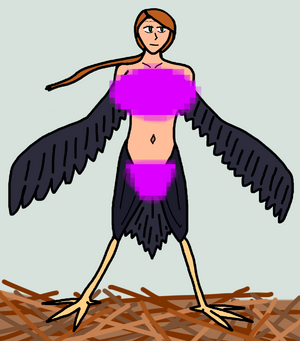Harpy: Difference between revisions
| Line 51: | Line 51: | ||
===Reproduction and Maturation=== | ===Reproduction and Maturation=== | ||
Harpies are parasitical reproducers, meaning that they need to find a member of the opposite sex within a different species to reproduce. In the case of harpies, they lack males, so they have to scavenge them from other species. Harpies most commonly pair with [[Boread|Boreads]] and humans. | |||
Keeping in line with other Aquitinian species, harpies are ovoviviparous, both producing and hatching their eggs within their own bodies. Due to the small size of harpies, and the relatively large size of their young, most give birth to only one or two young, with harpies generally struggling to carry even two eggs if they contain the male offspring of a larger species. | |||
Like other parasitical Aquitinia species, the male young grow up at the same rate as they would have if born from their own species. Harpies tend to grow up fast enough to fly on their own by two years old, though most do not fly far until they are ten. Harpies can reproduce by the time they are sixteen, being one of the fastest maturing Aquitinian species. Their faster development rate is believed by many biologists to be designed to counteract their lower than average brood size, as well as their generally more dangerous lifestyle. | |||
===Consumption=== | ===Consumption=== | ||
Revision as of 07:39, 12 November 2024
| Harpy | |
|---|---|

| |
| Perched Harpy, Blurred | |
| Scientific classification | |
| Kingdom: | |
| Division: | |
| Class: | |
| Order: | |
| Family: | |
| Genus: | |
| Species: | |
| Binomial name | |
| Harpyiae Umbrae | |
The Harpy is perhaps the second most widespread sapient species native to Aquitinia, behind only Mermaids. Their light weight and swift flying speed allows them to reach many lands other Aquitinian species do not even think of, and their near-supernatural ability to cope with filth and disease means that they rarely are unable to find food.
Like Mermaids, harpies can come in different varieties. However, these are much less disparate from one another than mermaid forms are, having a more consistent size range. They primarily differ in the style of feathers that they possess, with the common harpy being crowlike.
Harpies are nearly obligate carnivores, preferring to consume meat, but also willing to filch dairy. However, few Aquitinians mistake them for obligate carnivores as they are extremely well known for their love of bread. Harpies are also capable of consuming other grain based products, but are not as known for that. Some Aquitinians enjoy feeding the more docile feral harpies.
Etymology
Harpies are commonly mistaken as having gotten their name from the nuisance they cause, being associated with the term “harping”. However, their name has far more archaic origins, deriving from an ancient word that had to do with “snatching”. This is mostly likely due to the tendency common harpies have towards theft, usually done in a hit-and-run manner. In the case of more dangerous harpies, some researchers propose that the term may have been more euphemistically, referring to the lives of unaware people being snatched away.
History
Ancient
Modern Living
Biology
Physiology
Reproduction and Maturation
Harpies are parasitical reproducers, meaning that they need to find a member of the opposite sex within a different species to reproduce. In the case of harpies, they lack males, so they have to scavenge them from other species. Harpies most commonly pair with Boreads and humans.
Keeping in line with other Aquitinian species, harpies are ovoviviparous, both producing and hatching their eggs within their own bodies. Due to the small size of harpies, and the relatively large size of their young, most give birth to only one or two young, with harpies generally struggling to carry even two eggs if they contain the male offspring of a larger species.
Like other parasitical Aquitinia species, the male young grow up at the same rate as they would have if born from their own species. Harpies tend to grow up fast enough to fly on their own by two years old, though most do not fly far until they are ten. Harpies can reproduce by the time they are sixteen, being one of the fastest maturing Aquitinian species. Their faster development rate is believed by many biologists to be designed to counteract their lower than average brood size, as well as their generally more dangerous lifestyle.